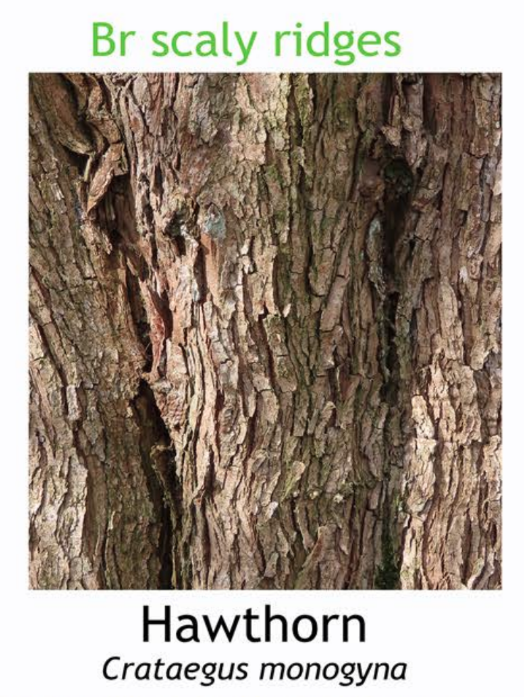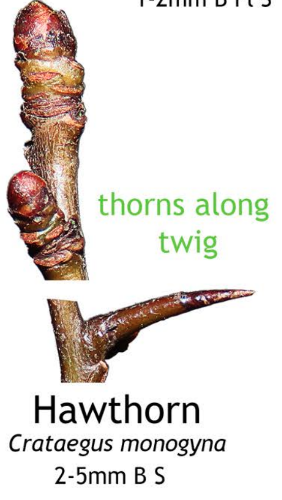A native deciduous tree species in Ireland, commonly found in woodlands, hedgerows, and scrublands.
Recognising the Hawthorn Tree:
-
Leaves: The leaves of the Hawthorn tree are alternate, lobed, and toothed along the margins. They are dark green in colour and have a glossy appearance. The leaves turn yellow to orange-red in autumn before falling.
-
Bark: The bark of the Hawthorn tree is smooth and greyish-brown when young, becoming rougher and darker with age. It often develops shallow fissures and ridges.
-
Flowers: Hawthorn trees produce clusters of small, white flowers in late spring to early summer. The flowers have five petals and a strong, sweet fragrance, attracting pollinators such as bees and butterflies.
-
Fruit: After flowering, Hawthorn trees produce small, red to black fruits known as haws. The haws are edible but have a sour taste and mealy texture. They are often used in culinary applications such as jams, jellies, and syrups.
-
Thorns: Hawthorn trees are characterised by long, sharp thorns that grow along the branches. The thorns serve as a defence mechanism against browsing animals.



5 Interesting Facts about the Hawthorn Tree:
-
Cultural Significance: The Hawthorn tree has cultural significance in folklore, mythology, and traditional medicine. It is often associated with May Day celebrations, fertility rituals, and protective charms. In some cultures, it was believed to have magical properties and was planted near homes for good luck and protection.
-
Wildlife Habitat: Hawthorn trees provide habitat and food for a variety of wildlife species. Birds feed on the fruits (haws), while insects pollinate the flowers and feed on the nectar and pollen. Mammals such as deer may also browse on the foliage.
-
Longevity: Hawthorn trees are known for their longevity, with some specimens living for several hundred years. They have a slow growth rate but can reach heights of up to 10-15 meters when mature.
-
Traditional Uses: Various parts of the Hawthorn tree, including the flowers, leaves, and berries, have been used in traditional medicine for their cardiovascular, digestive, and sedative properties. Hawthorn extracts and tinctures are used to treat conditions such as heart disease, high blood pressure, and anxiety.
-
Ecological Importance: Hawthorn trees play a vital role in ecosystems as habitat providers, soil stabilisers, and erosion preventers. Their dense foliage and thorny branches create shelter and nesting sites for birds and small mammals, while their deep root systems help prevent soil erosion and improve soil structure.
Uses of the Hawthorn Tree:
-
Culinary Uses: The fruits (haws) of Hawthorn trees are edible and can be used in culinary applications such as jams, jellies, syrups, and sauces. They are rich in vitamin C and antioxidants and have a tart flavor that becomes sweeter when cooked.
-
Medicinal Uses: Various parts of the Hawthorn tree, including the flowers, leaves, and berries, have been used in traditional medicine for their cardiovascular, digestive, and sedative properties. Hawthorn extracts and tinctures are used to support heart health, improve circulation, and reduce anxiety and stress.
-
Habitat Enhancement: Hawthorn trees are often planted for habitat enhancement and restoration projects due to their value as wildlife habitat providers. They create diverse micro-habitats that support a wide range of plant and animal species, contributing to overall biodiversity in woodlands, hedgerows, and scrublands.
Contribution to Biodiversity:
-
Habitat Provider: Hawthorn trees create diverse micro-habitats that support a wide range of plant and animal species. Their presence enhances habitat complexity and provides food, shelter, and nesting sites for wildlife, contributing to overall biodiversity in woodlands, hedgerows, and scrublands.
-
Pollinator Support: The flowers of Hawthorn trees provide an important nectar and pollen source for pollinators such as bees and butterflies. This supports pollinator populations and contributes to the health of ecosystems.
-
Food Source: The fruits (haws) of Hawthorn trees are an important food source for birds, particularly during the autumn and winter months when other food may be scarce. Birds such as thrushes, blackbirds, and finches feed on the haws, helping to disperse the seeds and promote the regeneration of Hawthorn trees.
In summary, the Hawthorn tree is recognisable by its lobed leaves, clusters of white flowers, and red to black fruits (haws). It holds cultural significance, provides valuable resources for wildlife, and contributes to biodiversity and ecosystem health in Ireland's woodlands, hedgerows, and scrublands. Additionally, it serves as an important food source for birds and other wildlife, supports pollinator populations, and enhances habitat complexity in natural ecosystems.
Images taken from the beautiful posters created by Phil Barnett and you can download these and/or purchase other great designs from his online shop.
